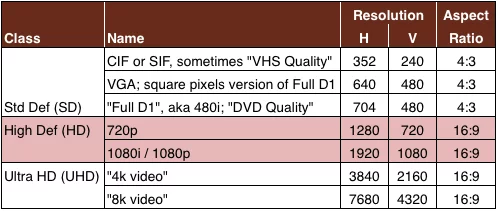The digital video industry seems destined to make resolution confusing. I just got back from NAB last week, where “4k video” was everywhere, and I want to tell you a story about video resolutions. (This is all using the resolutions that are common in the NTSC world, which basically means in the U.S. and Canada. The story is basically the same in the PAL world, meaning Europe and most of the rest of the world, but the numbers are all slightly different.)
Things were a little confusing in the days of standard definition (SD) video. The gold standard was referred to as “Full D1” resolution, which was named after a particular model of Sony tape deck that was a major breakthrough in broadcast video in the late 80s. “Full D1 resolution” meant 720 horizontal pixels by 480 vertical pixels. (SD was interlaced video, so one frame was made up of two consecutive fields, each 720×240).
When we started compressing this video in the early 90s, we immediately dropped the overscan area — 8 pixels on each of the left and right of the image that weren’t displayed on consumer TVs. People consequently started referring to “Full D1” as 704×480, because when you viewed video on a standard TV there was no difference. This resolution is also what people meant when they referred to “DVD Quality.”
SD video was always displayed in a 4:3 aspect ratio, which means the pixels weren’t square. This made some sense back in the days of CRTs, but it has always been a pain when you’re talking about LCDs and other forms of digital display, which have square pixels.
Then came high definition, and “Full D1” was rebranded as “480i” following the HD practice of naming resolutions after their number of vertical pixels: “720p” means 1280×720, and “1080i” and “1080p” both mean 1920×1080 (they differ in that one is interlaced and the other is progressive scan). 720p and the 1080 resolutions always have square pixels and so end up with a 16:9 aspect ratio.
Now we’re moving beyond HD to “Ultra HD,” and for some reason, I don’t understand why we have switched to referring to resolutions by their (approximate) number of horizontal pixels. So doubling “1080p” we get to a resolution of 3840×2160, which is “4k video.” There is also “8k video,” which is a doubling of 4k video to 7680×4320.
We really need to keep the marketing guys away from the “k” suffix. It was bad enough when they screwed up the measurement of hard disk storage, but at least, in that case, they were devaluing “k” from 1024 to 1000, which I guess was somewhat defensible. In 2013, with the Ultra HD resolutions, evidently “k” means 960!
To help keep it straight, here is a table that summarizes the more common video resolutions:

